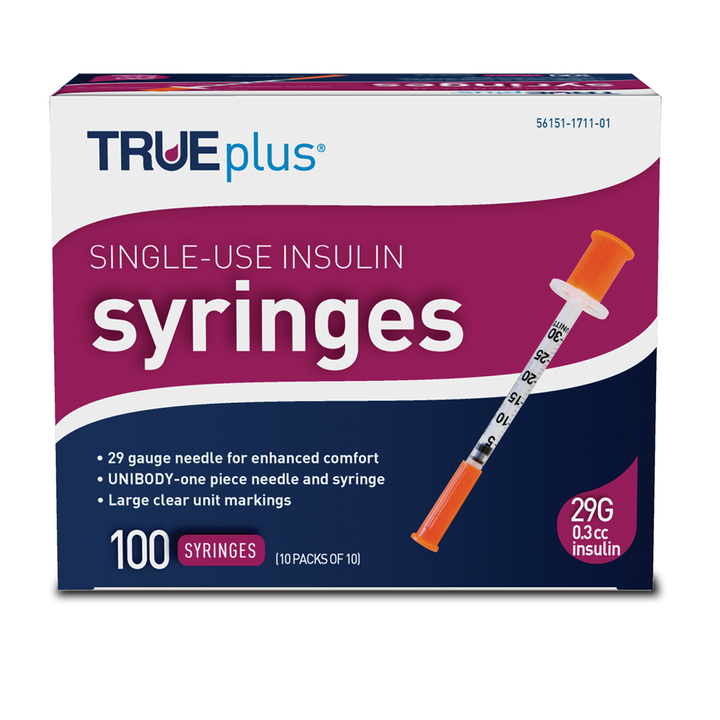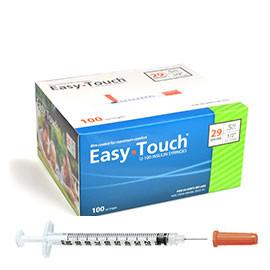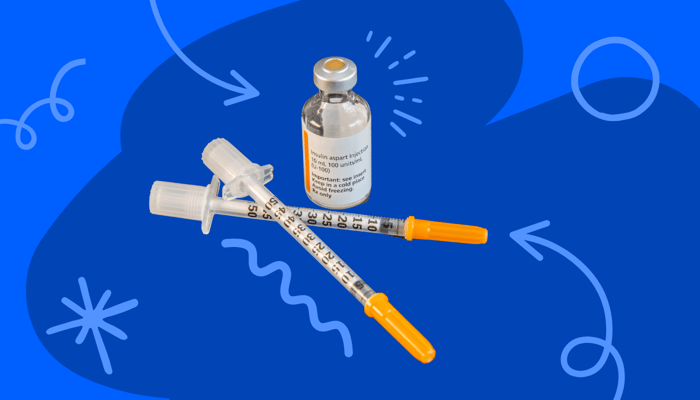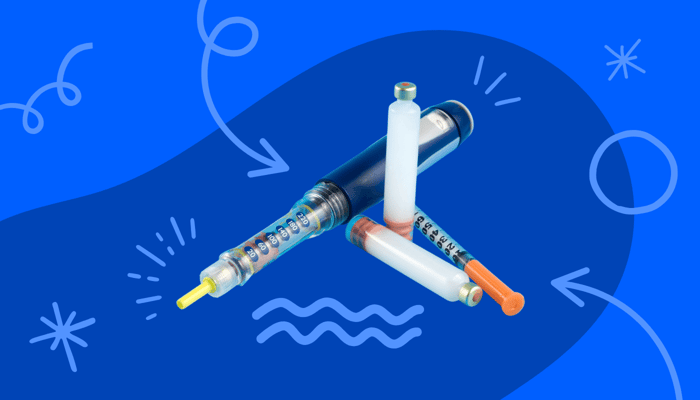Table of Contents
Choosing the right insulin syringe can be a confusing process. But when you’ve found a needle that works for you, injections become easier and safer. This quick guide to insulin syringe needle sizes will help you choose the best option that fits your needs and makes a difference in your daily routine.
What Are Insulin Syringes?
Syringes are medical tools used to inject medicine into your body. But an insulin syringe is specifically for people with diabetes to inject insulin.
Some people use syringes because they’re more affordable than other insulin injecting tools, like pens and pumps. Syringes are compatible with different types of insulin, including mixed formulas (if recommended by your doctor). And since syringes aren’t prefilled, you can adjust doses depending on your needs with professional guidance.
Insulin Syringe Components
An insulin syringe has three main parts: the needle, barrel, and plunger. Here’s a breakdown of each component to better understand its role in delivering medication.
Needle: The needle is the sharp part that goes into your skin to deliver insulin. It comes in many sizes and is measured by length and gauge (or width of the opening).
Barrel: The barrel holds the insulin. Barrels can be wide or narrow, depending on how much insulin you need to inject.
Plunger: The plunger controls what’s in the barrel. When you pull a plunger, the barrel fills through the needle from a vial. And when you push the plunger, the barrel empties through the needle into the injection site.
When choosing the right insulin syringe, the barrel and needle size matter most. Let’s discuss why next.
BD Embecta Ultra-Fine II Short Needle Insulin Syringe - 31G 3/10cc 5/16" - BX 90 (formerly BD)

$ 26.51
$ 33.14
Ultra Fine II short needle insulin syringes are designed for safety and comfort. These BD syringes are engineered with optimal point geometry and are coated with special Micro Bonded lubrication for a smoother entry. All Embecta needles are manufactured with… read more
Choosing the Right Insulin Syringe Needle Size
The best syringe needle size depends on how much insulin you’re injecting and your comfort level with needles. Once you know what barrel size to purchase, you’ll understand what needle gauge and length you may need.
Barrel Size
The barrel size determines how much insulin the syringe can hold for one dose. One syringe should hold enough for one dose.
0.3 milliliter (mL) barrels hold less than 30 units of insulin
0.5 mL barrels hold between 30 and 50 units of insulin
1.0 mL barrels hold more than 50 units of insulin (up to 100 units)
The smaller your unit dosage, the smaller syringe you need, and vice versa. If you choose one that’s too small, you may not inject enough to effectively control your blood sugar. And if you choose one that’s too big, you could accidentally inject too much. You may need two different syringe sizes if you take different doses throughout the day to avoid dose errors. Consult your healthcare professional if you’re unsure which barrel size you need.
Also consider that larger doses in bigger syringes may take longer to inject, but your needle’s gauge can make a difference.
TRUEplus Insulin Syringes - 29G .3cc 1/2" - BX 100

$ 13.38
$ 16.73
TRUEplus Single-Use Insulin Syringes are backed by a 10 out of 10 rating in laboratory testing*, and are an affordable, quality solution to promote compliance and safety. TRUEplus Diabetes Syringes Features: Silicone-coated, quality needles, with no burrs or surface imperfections… read more
Needle Gauge
A needle’s gauge, or thickness, determines how quickly and comfortably insulin can flow into the injection site. Most insulin syringes use needles with gauges ranging from 28 to 31. The smaller the gauge, the thicker the needle. For example, a 31-gauge needle is thinner than a 30-gauge one.
Thicker needles can deliver insulin quickly, but they may feel more uncomfortable. Many people prefer thinner needles because they’re less painful, but the injection might take longer for those with larger doses (or if the medication is on the thicker side). A mid-range size, like a 29 gauge, might be a good balance for many people.
Needle Length
Insulin syringe needles need to be long enough to reach the fatty layer under your skin called the subcutaneous tissue. This layer absorbs insulin at the correct rate for your dose to safely and effectively control your blood sugar.
But if your needle is too long, you may inject insulin into your muscle. This can be dangerous because muscle tissue absorbs insulin too quickly and could result in hypoglycemia, or excessively low blood sugar.
According to the International Scientific Advisory Board for the Third Injection Technique Workshop, all adults can use short 4- to 6-millimeter (mm) needles regardless of their body mass index, which is an estimated measure of body fat. Historically, people with more fat needed longer needles, but short needles are now considered the standard because they’re accurate and comfortable. However, short needles are more common among insulin pens rather than syringes.
There are exceptions where someone may need longer needles between 8 and 12.7 mm. Some doctors recommended a syringe with a longer needle to better control blood sugar levels or prevent insulin leakage out of the injection site. If you need a syringe with an 8- to 12.7-mm needle, review the injection technique with your doctor to make sure you’re delivering your medication correctly.
EasyTouch Insulin Syringes 29 Gauge .5CC 1/2in - BX 100

$ 20.09
$ 23.86
Comfort meets syringes; the EasyTouch Insulin Syringe is film coated for maximum comfort and lines up precisely for accurate dosage. They have no "dead space" for accurate dosage and less waste. 100% latex free. These 29 gauge Easy Touch insulin… read more
Bottom Line
When looking for the right insulin syringe needle size, gauge and length are important to consider. But your dosage and barrel size help determine which needle is best. If you’re unsure which insulin syringe to pick, check with your doctor to see what’s best for your prescribed dosage.
FAQs
What size needle is best for insulin injections?
Most needles for insulin injections are between 4 and 6 mm long and 28 to 32 gauge thick. Some needles can measure up to 12.7 mm long, but the best insulin syringe needle size for you depends on your doctor’s recommendation.
What’s the difference between a regular syringe and an insulin syringe?
Many syringes have long needles that reach the muscular layers of the body, like many vaccines. Insulin syringes are often smaller to deliver specific medication doses to the fatty layer under the skin.
What gauge and length needle are required for insulin injections?
The gauge and length of your syringe needle depend on your dose and comfort level. Thicker and longer needles tend to be more uncomfortable than thinner and shorter needles. If your doctor recommends a longer needle, you could balance comfort with a higher gauge.
Where can I buy insulin syringes over the counter?
You can buy insulin syringes over the counter in most pharmacies. Our shop at Total Diabetes Supply also sells a wide range of syringes, including pet syringes for our furry companions.







